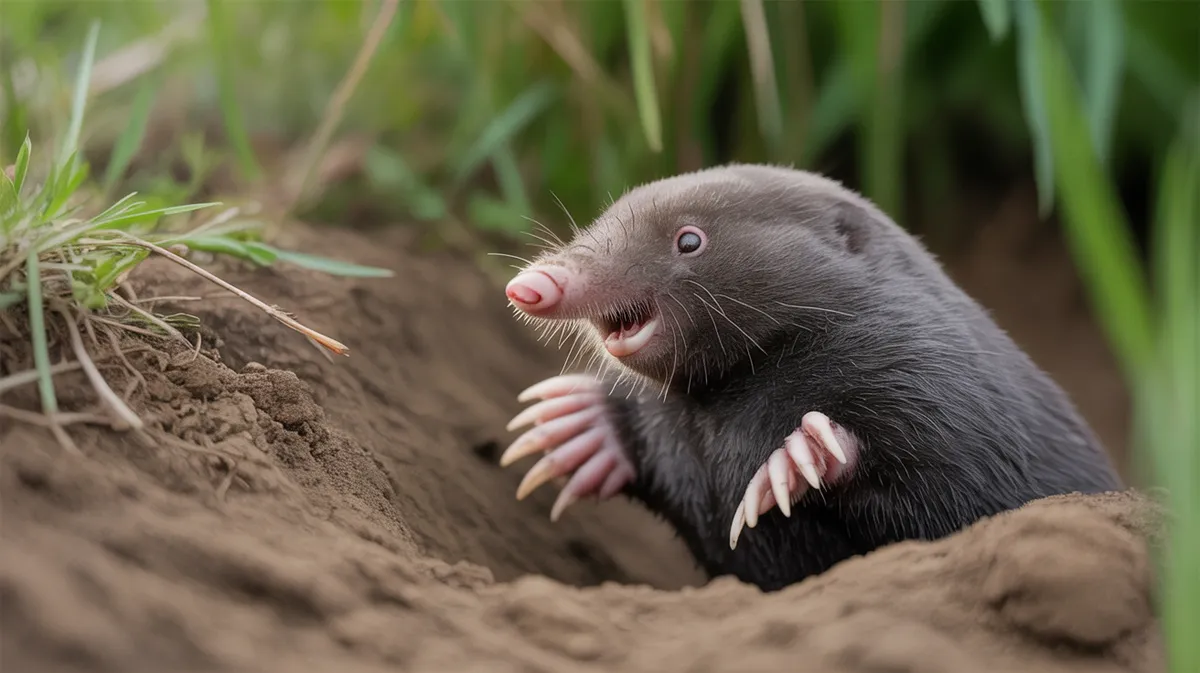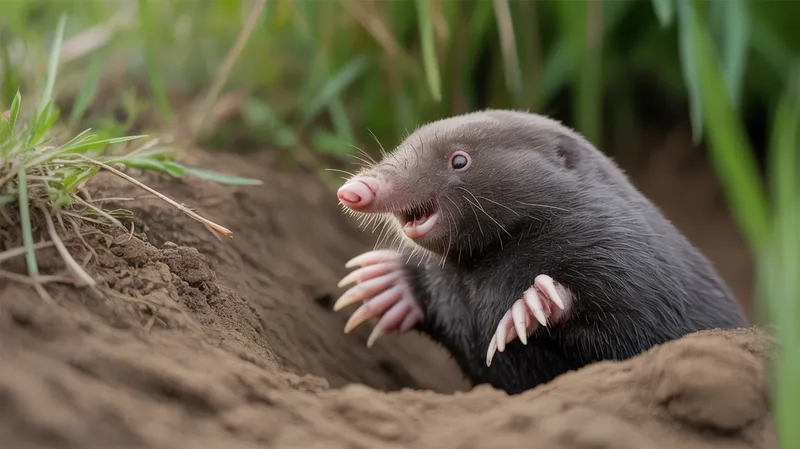
European Mole
Talpa europaea

Meet the European Mole
The European Mole is a small, fossorial mammal known for its velvety fur, cylindrical body, and powerful, spade-like forelimbs adapted for digging. This species spends nearly its entire life underground, creating complex tunnel systems throughout meadows, gardens, and woodlands across Europe and parts of Western Asia. Despite poor eyesight, the European Mole possesses an acute sense of touch and smell, which helps it locate prey such as earthworms and insects. Its presence is often revealed by the telltale molehills it leaves behind while excavating soil.
Classification
Mammal
Habitat
Underground burrows in grasslands, woodlands, and gardens
Diet
Carnivore
Lifespan
3-5 years
Conservation
Least Concern
Weight
70–130 grams
📖Fascinating Facts
Tunnel Experts
European Moles are exceptional diggers, constructing elaborate tunnel systems that can span hundreds of meters.
Super Senses
While nearly blind, moles have a highly developed sense of touch and smell, helping them find food underground.
Earthworm Hunter
Their diet consists mainly of earthworms, which they can immobilize with toxin-laden saliva and store alive for later feeding.
📋Detailed Description
The European mole (Talpa europaea) is a small, robust mammal typically measuring 11–16 cm in length, with a short, nearly hairless tail of 2.5–4 cm, and weighing between 70–130 grams. Its body is cylindrical and covered in dense, velvety black or dark grey fur, which can lie equally smoothly in any direction—an adaptation for moving forwards and backwards in tunnels. The forelimbs are highly specialized: broad, spade-like, and rotated outward, equipped with strong claws for efficient digging. The mole’s eyes are tiny and concealed within the fur, rendering its vision extremely limited, but it compensates with highly developed tactile and olfactory senses. The snout is elongated and highly sensitive, containing Eimer’s organs—specialized mechanoreceptors that detect vibrations and prey movements underground. The European mole is almost entirely subterranean, constructing elaborate tunnel systems that can extend over 100 meters, with specialized chambers for nesting and food storage. It is predominantly solitary, fiercely territorial, and only tolerates conspecifics during the breeding season. The species is insectivorous, with earthworms forming the bulk of its diet, supplemented by insect larvae and other invertebrates. Its metabolic rate is high, necessitating frequent feeding, and it can consume up to its own body weight in food daily. The European mole is distributed widely across Europe and parts of Western Asia, thriving in moist, well-drained soils of grasslands, woodlands, and cultivated areas.
💡 Did you know?
A single European Mole can eat its own body weight in food each day, consuming hundreds of earthworms, insects, and larvae.
🔬Research & Sources
Wikipedia Summary
The European mole is a mammal of the order Eulipotyphla. It is also known as the common mole and the northern mole.
Last Modified: 5/7/2025
🎭Behavior & Social Structure
European moles are solitary and territorial, with individuals maintaining exclusive tunnel networks that they aggressively defend from intruders. They are active year-round and do not hibernate, exhibiting polyphasic activity patterns with alternating periods of foraging and rest throughout the day and night. Moles use their acute sense of touch, aided by Eimer’s organs on the snout, to detect prey such as earthworms, insect larvae, and other soil invertebrates. They employ a unique hunting strategy: patrolling their tunnels and detecting vibrations or movements in the soil. When earthworms are abundant, moles may bite the head segment to paralyze them, storing them alive in underground larders for later consumption. Social interactions are limited outside the breeding season, and encounters between adults often result in aggressive displays or fights. Vocalizations are rare but may include high-pitched squeaks during conflicts or mating.
👶Reproduction & Life Cycle
The European mole’s breeding season typically occurs from February to June, varying with latitude and local climate. Males become more mobile during this period, expanding their tunnel systems in search of receptive females. After mating, gestation lasts approximately 4–5 weeks (28–35 days). Females give birth to a single litter per year, usually consisting of 3–7 naked, blind young. The nest chamber is lined with dry plant material for insulation. The young develop rapidly: their fur appears by the second week, eyes open at around 22 days, and they are weaned and independent by 4–5 weeks of age. Juveniles disperse above ground to establish new territories, a period associated with increased predation risk. Parental care is provided solely by the female.
🛡️Adaptations & Survival
The European mole exhibits a suite of remarkable adaptations for a fossorial lifestyle. Its forelimbs are highly modified, with an extra thumb-like bone (the prepollex) and outward rotation, maximizing digging efficiency. The velvety fur reduces friction against tunnel walls and allows for bidirectional movement. The mole’s lungs are adapted for low-oxygen environments, with a high affinity for oxygen and increased red blood cell count. Eimer’s organs on the snout provide exceptional tactile sensitivity, enabling the detection of prey through soil vibrations. The ability to paralyze earthworms with saliva allows for long-term food storage. Its kidneys are adapted to conserve water, an advantage in subterranean habitats. Behavioral adaptations include the construction of complex tunnel systems with specialized chambers for nesting and food storage.
📚Research Sources
🎨Cultural Significance
The European mole has a prominent place in European folklore and literature, often symbolizing industriousness, blindness, or the hidden workings of nature. In some rural traditions, moles were believed to bring good luck or, conversely, to be omens of misfortune due to their disruptive molehills. Mole fur, known for its softness, was historically used in fine clothing and accessories, though this practice has largely ceased. The mole features in children’s literature and popular culture, most notably as the character 'Mole' in Kenneth Grahame’s 'The Wind in the Willows.'
🔬Recent Research & Discoveries
Recent research has focused on the neurobiology of the mole’s tactile sense, revealing the extraordinary sensitivity of Eimer’s organs and their neural processing. Studies using high-resolution imaging have detailed the structure of the mole’s forelimb musculature and bone adaptations for digging. Genetic analyses have clarified the evolutionary relationships within the Talpidae family and the molecular basis of adaptations to hypoxic (low-oxygen) environments. Ongoing research addresses the ecological impact of mole tunneling on soil aeration, nutrient cycling, and invertebrate community dynamics. There is also interest in the mole’s resistance to certain soil-borne pathogens and its potential role as a bioindicator of soil health.
🎥Wildlife Videos

Moles: Nature’s Underground Engineers | Wildlife Documentary | Fusion Documentary
Moles: Nature's Underground Engineers | Wildlife Documentary | Fusion Documentary.
Fusion Documentary

Busy Beavers Build Dam Ahead of Winter | Yellowstone | BBC Earth
Autumn is the busiest time of the year for beavers – dams must be built in order to ensure they can survive the harsh winter ...
BBC Earth

European Mole, Talpa europaea, Mol, Landtong Rozenburg, ZH, the Netherlands, 30 Aug 2021
This European Robin (Erithacus rubecula) follows the Mole who disturbs quite a few earthworms, an easy prey for the Robin.
Remco Hofland

European Mole (Talpa Europaea)
(English) European Mole (Talpa Europaea). _ (Português) Toupeira Europeia (Talpa Europaea). _ (Français) Taupe Européenne ...
animalsinternet

Wild Life Skills #6 - Mole watching
Nick Baker introduces us to an unsual garden visitor - the mole. This is a rare chance to get up close to this elusive and rarely ...
WildlifeWatchUK

Mole | “Moles are among the most remarkable diggers in the animal kingdom.
In human culture, moles are animals that have sometimes conjured up images of industry and hard work. With their massive claws ...
Animal Square
🌍Habitat Information
The European Mole typically inhabits Underground burrows in grasslands, woodlands, and gardens environments. European Moles have adapted to their environments with specialized features and behaviors.
Primary Habitat:
Underground burrows in grasslands, woodlands, and gardens
More detailed habitat information will be available soon.
🛡️Conservation Status
The European Mole is currently classified as Least Concern. Conservation efforts are crucial for preserving this species for future generations.
Common Threats:
- 🏠Habitat loss and fragmentation
- 🌡️Climate change impacts
- 🎯Hunting and poaching
- 🏭Human-wildlife conflict
⚠️Threats & Conservation Challenges
Currently, the European mole is classified as Least Concern by the IUCN due to its wide distribution and stable population. However, localized threats include habitat loss from intensive agriculture, urbanization, and soil compaction. Moles are sometimes persecuted as pests in gardens, golf courses, and agricultural fields, leading to targeted trapping or poisoning. The use of pesticides and soil contaminants can reduce prey availability and directly harm moles. Natural predators include foxes, weasels, owls, and domestic cats, particularly during above-ground dispersal of juveniles. Climate change may alter soil moisture and prey abundance, potentially impacting mole populations in the future.
🔬Scientific Classification
Scientific Name
Talpa europaea
Classification Hierarchy
🔍 About Taxonomic Classification
Taxonomic classification is a hierarchical system used by scientists to classify and organize living organisms based on shared characteristics and evolutionary relationships.
The system moves from broad categories (Kingdom) to increasingly specific ones, with each animal's scientific name typically consisting of its Genus and species.
📝Community Notes
Share your observations and insights about the European Mole with our community of wildlife enthusiasts.
Join Our Community
Sign in to share your observations and connect with fellow wildlife enthusiasts.
Sign In to ContributeNo community notes yet
Be the first to share your observations about the European Mole!
Explore European Mole
Select a tab above to learn more about this amazing animal.
📸Photo Gallery
No photos available for this animal yet.
🌟Discover More Wildlife
Continue your journey of discovery with more fascinating animals from our database
